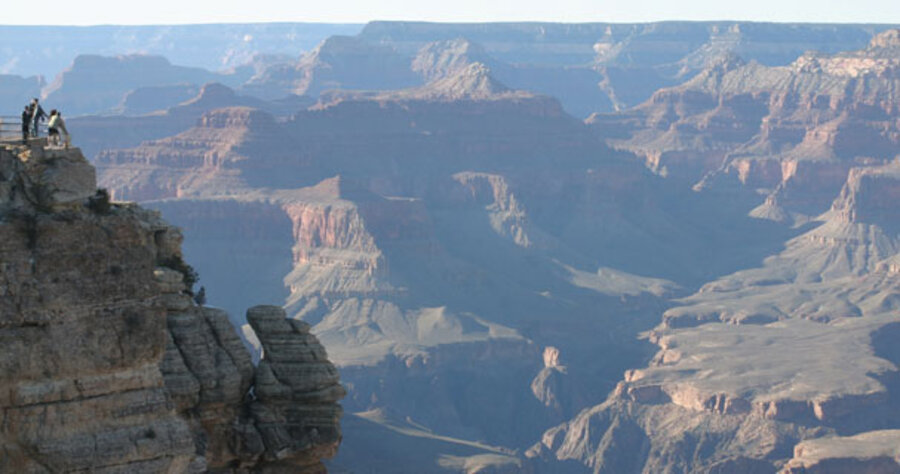Grand Canyon site of renewed mining rush
Loading...
Visit Arizona's majestic Grand Canyon in the coming years, and you'll be able to take in a number of spectacular sights: Eagle Rock, Walhalla Overlook, the uranium mines, Bright Angel Overlook. . .
Hang on. The uranium what?!
That's right. Renewed interest in nuclear power as a low-carbon energy source, as well as the depletion US power plant's nuclear stockpiles from the 1980, has caused prices for the radioactive metal to soar, making the Grand Canyon an attractive site for potential miners.
According to a story in Sunday's Los Angeles Times, there are now more than 1,100 uranium claims on public lands within five miles of Grand Canyon National Park. At the beginning of 2003, there were only 10 claims. Many of these claims are by overseas companies, such as Vane Minerals, a British company that was granted approval in December for exploratory drilling at seven sites near the canyon's popular South Rim.
The LA Times story describes the concerns surrounding the extraction of uranium ore near a popular tourist destination, wildlife habitat, and source of drinking water.
The energy-versus-environment debate is apparent within the Interior Department, which granted the mining claims through its Bureau of Land Management. Among the mining critics is Steve Martin, superintendent of the Grand Canyon park and an Interior Department employee himself. "There should be some places that you just do not mine," Martin said.
Uranium is "a special concern," he added, because it is both a toxic heavy metal and a source of radiation. He worries about uranium escaping into the local water, and about its effect on fish in the Colorado River at the bottom of the gorge, and on the bald eagles, California condors and bighorn sheep that depend on the canyon's seeps and springs. More than a third of the canyon's species would be affected if water quality suffered, he said.
Martin is not the only one uneasy about potential water contamination. Add to the list the Metropolitan Water District of Los Angeles, which sells wholesale water throughout Southern California from its Colorado River Aqueduct. "In addition to the public health impacts, exploration and mining of radioactive material near a drinking water source may impact the public's confidence in the safety and reliability of the water supply," the district's general manager, Jeffrey Kightlinger, wrote in March to Interior Secretary Dirk Kempthorne.
Thanks to an 1872 mining law intended to spur westward expansion, the US Forest Service had no choice but to approve the drilling, which they did without any public hearing or environmental review.
Environmental groups such as Earthworks, a nonprofit that focuses on hard-rock mining, have called for the law to be updated. They have an ally in Rep. Nick Rahall, a West Virginia Democrat who since 1985 has been attempting to change the law. But even with a majority Democrat congress, his efforts have faced considerable opposition, particularly from Senate Majority Leader Harry Reid, whose home state of Nevada depends on mining.
For their part, Vane Minerals, the British company that is drilling near the canyon's South Rim, believes that their operations will have minimal environmental impact. At a hearing in Flagstaff, Ariz., of the US House subcommittee on national parks and public lands, Vane's Chief Operating Officer Kris Hefton pointed out that the uranium ore found near the Grand Canyon is found in compact breccia pipes, which unlike other types of deposits, can be mined in a small area.
During the West's first uranium boom, in the 1940s and 50s, many of the miners, whose ranks were largely drawn from American Indian nations, fell ill after being exposed to high levels of radon gas. In 1990 the US Department of Justice instituted the Radiation Exposure Compensation Program, which to date has paid out more than $1.1. billion to workers, as well as those living downwind of a nuclear weapons test site in Nevada.
"I'm not talking about the industry of 50 years ago that impacted the Navajo Nation or others in the Four Corners area," said Hefton. "We ask you to judge our industry on its current performance rather than on past, unrelated events."





